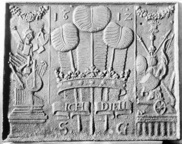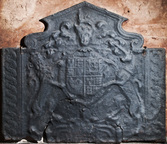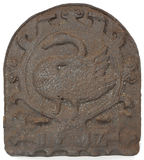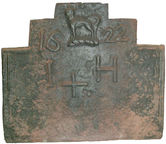-
995
Description: Arched; fillet edging; English royal Stuart shield, garter, crown, supporters, 'CS' monogram to left of Garter buckle, and motto on a cartouche; small rose stamp repeated each side of crown; date split each side of top of crown (first part absent in this casting).
Notes: Although English arms, the design is in a continental style, arched firebacks being typical of Lorraine; the 'CS' monogram is likely to be that of the pattern-maker; a modern copy of a poor casting, hence the incomplete date. For the complete version see no. 994.
Copies of this fireback are known.
Inscription: [16 missing] 21 / HONI SOIT QVI MAL Y PENSE / CS / DIEV ET MON DROIT
Arms: English Stuart royal (James I)
- Decoration tags:
- rounded arched (shape)
- cavetto (edging)
- whole carved pattern
- planklines
- monogram
- armorial
- royal
- text
Manufactured: in 1621 in England.
Current location: not known.
- Attached to series:
- Jacobean royal armorial firebacks
- Stuart royal armorial firebacks
-
1291
Description: Rectangular shape; astragal with cavetto-moulded edging; decoration in three vertical sections each divided by a fillet; central section: three ostrich feathers within a coronet and a motto scroll - ICH DIEN (I serve); at the top, the date split either side of the uppermost feather; at the bottom, initials - SG - split either side of the quills; left panel: on a pedestal, an arrangement of musical and scientific instruments and books below a floral swag with a central rose; right panel: on a palisade, a triumph of martial arms - cannon, drum, shield, spear, flag etc. - beneath a floral swag and handful of arrows.
Notes: The three ostrich feathers within a coronet and the motto, Ich Dien, are the badge of the Prince of Wales. Probably a fireback in honour of Henry Frederick, Prince of Wales, oldest son and heir of King James VI of Scotland, I of England, with the date added to commemorate his death in 1612. The initials are likely to be those of the pattern maker.
Inscription: 16 12 / ICH DIEN / S G
- Decoration tags:
- rectangular (shape)
- astragal with cavetto (edging)
- whole carved pattern
- individual numbers
- heraldic
- pictorial
- historical
- architectural
- royal
- text
- objects
Manufactured: in 1612 in the Eifel area of Germany.
Current location: not known.
Museum number: RBA 37533 (part of the Ahrgau-Museum, Ahrweiler museum group)
- Attached to series:
- Prince of Wales firebacks
- Miscellaneous royal firebacks
-
937
Description: Arched rectangular shape; gadrooned edging (top and sides); initials, in separate stamps, at top of arch; date probably in separate stamps, below, split by spindle; spindle used as a stamp repeated three times, one between date and initial stamps, the other two below to left and right.
Notes: Makes use of the same backing board as other firebacks in this series, and the same three spindles but with other initials; it may originate in the Cuckfield area of Sussex, where most examples have been noted; illustration from Harper (1906). Previously at Riddens (now West Riddens) Farm, Ansty, near Cuckfield, Sussex.
Inscription: S WC / 16 22
- Decoration tags:
- rectangular with round arch (shape)
- gadrooned (edging)
- simple stamps
- individual letters
- individual numbers
- text
- objects
Manufactured: in 1622 possibly at Cuckfield Furnace in the Weald area of England.
Current location: not known.
Citation: Harper, C. G., 1906, The Brighton Road (London, Chapman & Hall), p. 391.
- Attached to series:
- Spindle series
- Date & initials firebacks
- Spindle/distaff firebacks
-
932
Description: Carved wooden fireback pattern. Canted arched rectangular shape with cavetto-moulded astragal edging; coronet in arch; oval shield with a crowned lion lion rampant, supported two griffons reguardant, the whole within a cartouche, the bottom of which terminates in two swirls between which is a human mask.
Notes: Theodore Agrippa d'Aubigné
Arms: Theodore Agrippa d'Aubigné
- Decoration tags:
- rectangular with canted top corners and round arch (shape)
- astragal with cavetto (edging)
- whole carved pattern
- planklines
- armorial
Manufactured: in the early-17th century in France.
Current location: not known.
Citation: Carpentier, H., 1912, Plaques de Cheminées (Paris, published by the author).
- Attached to series:
- Patterns
- Personal armorial firebacks
-
849
Description: Rectangular with superimposed arch; embattled, cavetto moulded edging, with the top edge of the rectangle interrupted; shield, garter, crown, supporters and motto of the English Royal house of Stuart; rose and thistle plants above lion and unicorn supporters respectively; initials split by crown; date below garter.
Notes: A version dated 1619 is proportioned slightly differently and has smaller rose and thistle plant stamps.
Copies of this fireback are known.
Inscription: I R / 16 21
Arms: English Stuart royal - James I
- Decoration tags:
- rectangular with round arch (shape)
- embattled cavetto (edging)
- whole carved pattern
- armorial
- royal
- text
Manufactured: in 1621 in England.
Current location: in private hands, Ashurst, West Sussex, England.
-
1319
Description: Rectangular with pediment raised on inverted consoles; fillet edging, ovolo-moulded in the pediment; shield, garter, helm, mantling, crest of a lion surmounting a chapeau, and motto cartouche with obliterated text; on each side, an extension panel with a vertical guilloche pattern.
Notes: One of several firebacks, all varying in size, framing style and moulding, with stylistic features in common and almost certainly the work of the same pattern maker, who was also responsible for carving royal coats of arms in several West Country churches. The presence of the chapeau, or Cap of Maintenance, is unusual on arms of this period, it being more common on medieval achievements.
Copies of this fireback are known.
Arms: English Stuart royal
- Decoration tags:
- rectangular with detached pediment (shape)
- fillet (edging)
- whole carved pattern
- extension panels
- heraldic
- armorial
- royal
Manufactured: in the early-17th century in England.
Current location: Barnstaple Guildhall, Butchers Row, Barnstaple, Devon, England.
- Attached to series:
- Bristol armorial group
- Stuart royal armorial firebacks
-
277
Description: Arched rectangular with cavetto-moulding along top, supported by Ionic pilasters; English Stuart royal shield, garter, helm, crown, motto and supporters; date below and either side of garter.
Notes: One of several firebacks, all of the same date, but varying in size, framing style and moulding; all have stylistic features in common and will have been the work of the same pattern maker, who was also responsible for carving royal coats of arms in three West Country churches. Mendip Auctions, Binegar, 11 Dec 2021, lot 537.
Copies of this fireback are known.
Inscription: I R [Jacobus Rex] / HONI SOIT QVI MAL Y PENSE / 16 18 / DIEV ET MON DROIT
Arms: English Stuart royal (James I)
- Decoration tags:
- rectangular with round arch (shape)
- complex individual (edging)
- whole carved pattern
- architectural
- armorial
- royal
- text
Manufactured: in 1618 possibly in the Forest of Dean area of England.
Current location: not known.
-
204
Description: Canted rectangle; twisted rope edging (top and sides); Tudor royal shield and Garter with crown above, between lion and unicorn supporters; initials separated by crown; a small ring and bar are placed to the left of the unicorn’s mouth.
Notes: The Tudor shield and crown feature on many Wealden firebacks, and have here been reused with Jacobean supporters; their stamps are derived from standing models.
Inscription: I R
Arms: Tudor royal
- Decoration tags:
- rectangular with canted top corners (shape)
- rope (edging)
- carved stamps
- individual letters
- heraldic
- armorial
- royal
Manufactured: in the early-17th century possibly at Pounsley Furnace, Framfield in the Weald area of England.
Current location: St Mary's Abbey, Blanchland, Northumberland, England.
- Attached to series:
- Pounsley series
- Jacobean royal armorial firebacks
-
889
Description: Arched shape; fillet edging; swan within a voided strapwork cartouche; date in Arabic numerals, at bottom, on a broad horizontal fillet.
Notes: Stylistically, of the early 17th century, suggesting the date is 1617, although the third numeral is indistinct. Bonham's sale, Chester, 18 October 2012, lot 384 (£375).
Inscription: 16 1[?]7
- Decoration tags:
- rounded arched (shape)
- fillet (edging)
- whole carved pattern
- heraldic
- architectural
- text
- animals
Manufactured: in 1617 in England.
Current location: not known.
- Attached to series:
- Miscellaneous pattern firebacks
-
206
Description: Rectangular with two-stepped top; double astragal edging on sides; top centre, stamp formed of a talbot statant guardant upon a wreath; date split either side of crest; initials below date, ‘+’ below letters.
Notes: The talbot crest is seen on other firebacks indicating a common source.
Copies of this fireback are known.
Inscription: 16 22 / I + H
- Decoration tags:
- stepped (shape)
- fillet (edging)
- simple stamps
- carved stamps
- individual numbers
- heraldic
- text
Manufactured: in 1622 in the Weald area of England.
Current location: St Mary's House, Bramber, West Sussex, England.
- Attached to series:
- Talbot crest series
- Stepped firebacks


.jpg)
 carpentier p229 690x870.png)





